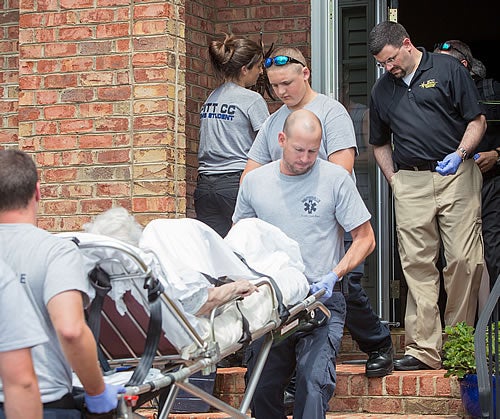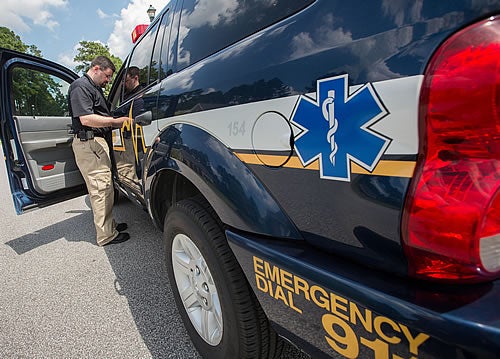‘DOING EVERYTHING WE CAN’
ECU emergency physicians respond to EMS calls
Video and photography by Cliff Hollis
Dr. Jeffrey Ferguson was having a quiet summer afternoon recently when a call came in on his radio. A person had called 9-1-1 reporting that a female relative in her 80s was complaining of stroke-like symptoms. The caller was in a nearby neighborhood.

Dr. Jeffrey Ferguson, in the black shirt, exits a home after evaluating a woman complaining of stroke-like symptoms.
Ferguson responded to the dispatcher, turned on his Dodge Durango’s emergency lights, maneuvered through traffic and sped down Fire Tower Road.
He arrived at the home just ahead of Winterville emergency medical services, and together they evaluated the patient and prepared her for transport to Vidant Medical Center. She wasn’t having a stroke, but at her age, nothing could be taken lightly.
“Still needs to go to the hospital and get checked out,” Ferguson said.
Ferguson, an assistant professor of emergency medicine at the Brody School of Medicine at East Carolina University, is the medical director of EMS for Pitt County. And thanks to a partnership with Pitt County, the city of Greenville and the ECU Department of Emergency Medicine, ECU emergency physicians are now going out on some EMS calls.
The partnership puts an emergency physician in the field “to be out and about amongst the paramedics to help them manage difficult cases,” said Dr. Theodore Delbridge, chair of the Department of Emergency Medicine at the Brody School of Medicine at ECU.
“Our hope is it will improve the efficiency and capabilities of the emergency response system.”
Pitt County supplied a late-model Dodge Durango SUV for doctors to drive to emergency scenes. The city of Greenville agreed to provide regular maintenance for the Dodge. ECU stocks the Durango with supplies and provides the doctors.
As of early September, ECU physicians had responded to approximately 80 incidents since the program began earlier this year.
ECU emergency physicians have a smart phone application that allows them to receive dispatch information from the county 911 center. The physician on EMS call can then determine if a physician could help at the scene and if he or she is available to go.
“I’m an old paramedic,” Ferguson said, “so I’d probably rather be out here than in the E.D.”
Emergency medical services involve emergency patient care, including initial patient stabilization, treatment and transport in ambulances or helicopters to hospitals. Delbridge said physicians at the scene can help evaluate those involved in trauma or medical emergencies and determine if they need to be transported to the hospital. Not transporting the uninjured can save significant time and money for the individual, the hospital and the EMS system.
With a qualified physician on hand, sometimes the increased level of care can improve a patient’s outcome. In other cases, when victims cannot be resuscitated from cardiac arrest, for example, they can be pronounced dead at the scene, preventing the need for transportation to a hospital for futile care and relieving loved ones of false hopes.

Ferguson speaks with dispatch personnel while out on an emergency call.
“We’re trying to improve survival by actually doing everything we can at the scene of the collapse rather than putting the patient in an ambulance and taking them to the hospital,” Ferguson said.
Having physicians at the scene can also help educate other EMS workers, Delbridge said.
Physicians can guard against adverse medication interactions, interpret electrocardiogram strips, communicate more thoroughly with doctors at the hospital and more, said Interim Chief Eric Griffin of Greenville Fire and Rescue. They are valuable on calls in rural areas where EMS personnel don’t include paramedics, Griffin said.
“There are a lot of calls that are very complex, and having a physician on scene not only saves time but also helps give the patient the best care possible,” Griffin said.
In June, Ferguson responded to the scene of a gunman in the parking lot of the Wal-Mart on Greenville Boulevard and led the triage of shooting victims. Earlier this year, ECU’s Dr. Bill Price responded to the scene of a school bus wreck near Ayden and evaluated student riders. Doing so at the scene kept them from having to be taken to the emergency department.
“That way, we don’t have to tie up so many resources transporting them to the hospital,” Griffin said.
Ferguson said the response from patients’ families has been positive.
“It’s a huge comfort, it seems, to the family to introduce myself as Dr. Ferguson from the emergency department,” he said.
About a half-hour after seeing the woman with stroke-like symptoms, a call came in about a man suffering heat exhaustion. When Ferguson got to the scene, the man, who had been working outside, was already being treated by Winterville EMS. He wanted to go home until his supervisor told him he would need a doctor’s note to come back to work.
“He’ll be transported to the hospital and get some fluids,” Ferguson said. “He’ll wake up a different man.”
Other ECU emergency medicine faculty members with expertise in EMS are Drs. Juan March, David Thomson, Jocelyn De Guzman and Emilie Pendley, who is medical director of EMS in Beaufort County.

Dr. Jeffrey Ferguson is shown next to the Dodge Durango ECU physicians drive to the scene of EMS calls.